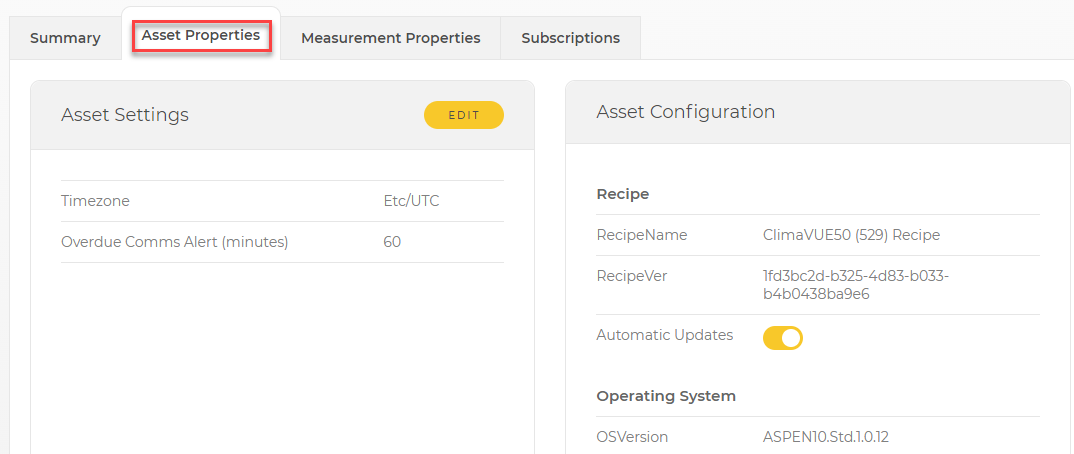Assets
The Assets application is used to manage ![]() assets Primarily this is a data source such as a data logger or Aspen 10. It can also be another piece of hardware. (data sources such as the
assets Primarily this is a data source such as a data logger or Aspen 10. It can also be another piece of hardware. (data sources such as the ![]() onboarded A collective term for the tasks that have to complete successfully in order for a data source asset to be correctly configured and send data to CampbellCloud. These tasks may be automated or require manual user input depending on the data source type. For data logger data sources, these tasks include asset claiming, automated sensor identification, cellular communications registration, secure CampbellCloud communications, program retrieval, successful sensor measurement, and confirmation that CampbellCloud received data., will appear in a tabular view.
onboarded A collective term for the tasks that have to complete successfully in order for a data source asset to be correctly configured and send data to CampbellCloud. These tasks may be automated or require manual user input depending on the data source type. For data logger data sources, these tasks include asset claiming, automated sensor identification, cellular communications registration, secure CampbellCloud communications, program retrieval, successful sensor measurement, and confirmation that CampbellCloud received data., will appear in a tabular view.
Click on the asset name to see its details.
On the main Assets page, click the name of the asset to view its health and status Summary, Asset Properties, Measurement Properties, and Subscription information.
The Asset Properties tab provides access to the overdue communications alert time setting. Additionally, Asset Configuration information, such as recipe name and version, operating system version, and cellular version are shown.
Changes made to an asset affect all users who have access to that asset.
Click the toggle switch to turn on or off the recipe and operating system automatic updates. A yellow switch indicates that automatic updates are on.
The Measurement Properties tab provides a list of measurements. Clicking on an individual measurement opens a measurement properties window that can be used to configure measurement ![]() Classification Refers to the primary classification of a measurement, such as tempreature, relative humidity, or precipitation.,
Classification Refers to the primary classification of a measurement, such as tempreature, relative humidity, or precipitation., ![]() Subclassification Refers to the secondary classification of a measurement. For example, a temperature classification can have multiple subclassifications, such as air temperature, dew point temperature, or soil temperature,
Subclassification Refers to the secondary classification of a measurement. For example, a temperature classification can have multiple subclassifications, such as air temperature, dew point temperature, or soil temperature, ![]() Units Specifies the unit type of the incoming measurement into CampbellCloud. For example, if the asset is sending a temperature measurement to CampbellCloud in degrees Celsius, Units must be set to degrees Celsius.,
Units Specifies the unit type of the incoming measurement into CampbellCloud. For example, if the asset is sending a temperature measurement to CampbellCloud in degrees Celsius, Units must be set to degrees Celsius., ![]() Aggregate Type Denotes the aggregate type for the incoming measurement into CampbellCloud. For example, if the incoming measurement is a minimum value (for example, minimum battery voltage), set aggregate type to minimum., and
Aggregate Type Denotes the aggregate type for the incoming measurement into CampbellCloud. For example, if the incoming measurement is a minimum value (for example, minimum battery voltage), set aggregate type to minimum., and ![]() Precision Specifies the number of decimal places shown for a measurement..
Precision Specifies the number of decimal places shown for a measurement..
Use measurement Classifications, Subclassifications, and Units in conjunction with My Settings > Unit Preferences to affect how your measurements are displayed throughout Cloud. The Measurement Properties must be set to match the data being sent to CampbellCloud.
Adding measurement units may reduce the number of measurements that can be displayed at one time on a Data Explorer graph. See Data Explorer.
For detailed instructions on adding an asset to CampbellCloud, see Adding an asset in the Assets app.



